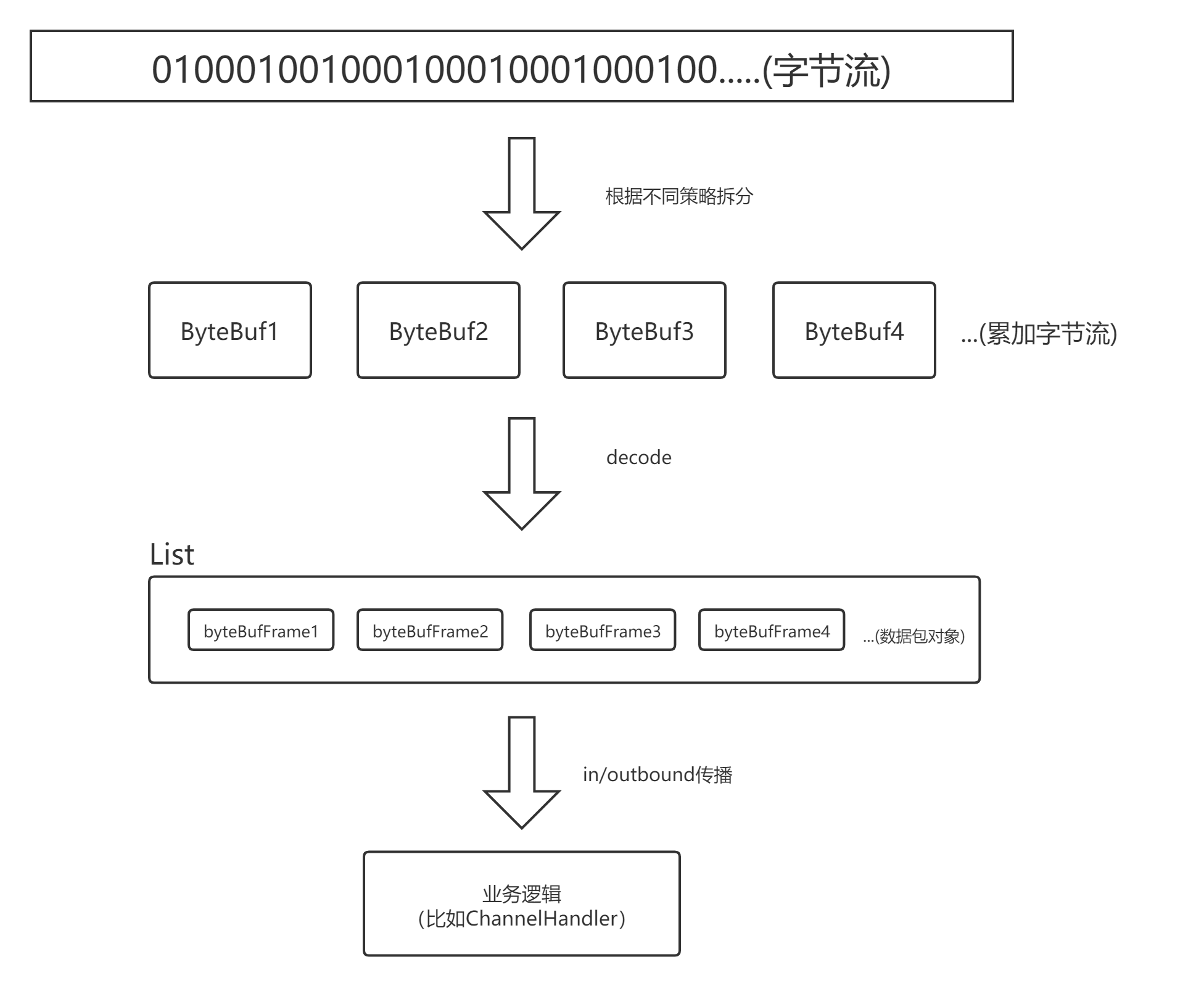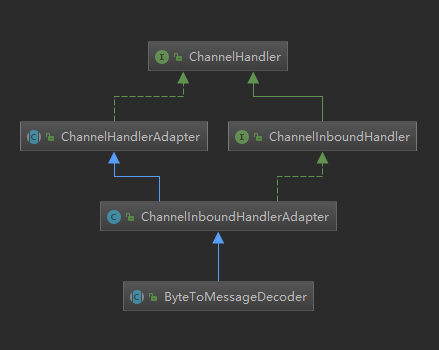文章目录
前言
本节就来看看Netty解码的通用抽象ByteToMessageDecoder、以及Netty中最简单的定长解码器FixedLengthFrameDecoder。
在看之前尽量保证有一定的ByteBuf基础,如必须知道readerIndex和,writerIndex等,可以参考我前面的博客记录【ByteBuf简介】。
Netty Version:4.1.6
解码的大致流程
画个流程图表示:

ByteToMessageDecoder
ByteToMessageDecoder继承关系、意义
看完上面的流程图,现在来看看Netty的ByteToMessageDecoder是如何体现这一流程的。
首先看一下ByteToMessageDecoder的继承关系简单预测它能做什么:

- 关于图中的几个类,我在【inbound和oubound事件区别】提到过。
从上面的类图,再结合之前pipeline的学习经历,不难发现,我们其实可以把ByteToMessageDecoder以及它的实现当成ChannelHandler,也就是说解码其实是事件传播、处理中的其中一环。用代码表示就是类似下面这个样子:
// 略
.childHandler(new ChannelInitializer<SocketChannel>() {
@Override
public void initChannel(SocketChannel ch) {
ch.pipeline().addLast(new Base64Decoder());
ch.pipeline().addLast(new FixedLengthFrameDecoder(3));
ch.pipeline().addLast(new LineBasedFrameDecoder(10, false, false));
}
知道了ByteToMessageDecoder的继承关系和意义之后,不妨再来看看它的源码是如何体现上面讲到的解码流程的。
解码流程的代码体现
首先,一般都是服务端接受到客户端的数据才会需要解码的,而服务端读数据并传播的方法就是channelRead,所以现在找到ByteToMessageDecoder的channelRead方法,顺便把用到的属性分析下:
此处【坐标1】:
io.netty.handler.codec.ByteToMessageDecoder#channelRead
@Override
public void channelRead(ChannelHandlerContext ctx, Object msg) throws Exception {
if (msg instanceof ByteBuf) {
// 暂时未知具体作用,根据类文档,当成ArrayList就可以了,或者自己根据类图简单分析下
// 视频说是存储解析到的对象的list
CodecOutputList out = CodecOutputList.newInstance();
try {
ByteBuf data = (ByteBuf) msg;
// 判断是否第一次从IO流读取数据
first = cumulation == null;
if (first) {
// 如果是第一次读取,则累加器直接=data
cumulation = data;
} else {
// 否则将当前累加器的数据和新读到的数据进行累加
// 下文会继续跟进cumulator,它是累加器实现
cumulation = cumulator.cumulate(ctx.alloc(), cumulation, data);
}
// 调用子类的decode方法进行解码
callDecode(ctx, cumulation, out);
} catch (DecoderException e) {
throw e;
} catch (Throwable t) {
throw new DecoderException(t);
} finally {
if (cumulation != null && !cumulation.isReadable()) {
// 没东西可读了,释放累加器bytebuf
numReads = 0;
cumulation.release();
cumulation = null;
} else if (++ numReads >= discardAfterReads) {
// We did enough reads already try to discard some bytes so we not risk to see a OOME.
// See https://github.com/netty/netty/issues/4275
numReads = 0;
discardSomeReadBytes();
}
// 获取到解析到的对象的数量
int size = out.size();
decodeWasNull = !out.insertSinceRecycled();
// 将解析到的对象向下传播
fireChannelRead(ctx, out, size);
// 最终回收out对象至对象池以便于复用对象
out.recycle();
}
}
// 不是ByteBuf则往下传播
else {
ctx.fireChannelRead(msg);
}
}
累加字节流
下面再来看看字节流累加器是如何实现的,也就是上面遇到的cumulator.cumulate方法,追到源头看看:
io.netty.handler.codec.ByteToMessageDecoder#MERGE_CUMULATOR
/**
* Cumulate {@link ByteBuf}s by merge them into one {@link ByteBuf}'s, using memory copies.
*/
public static final Cumulator MERGE_CUMULATOR = new Cumulator() {
@Override
public ByteBuf cumulate(ByteBufAllocator alloc, ByteBuf cumulation, ByteBuf in) {
ByteBuf buffer;
// 这个if其实就是判断cumulation有没有空闲空间写,如果返回true就说明扩容的意思
// 结构可参考:https://wenjie.store/archives/about-bytebuf-1
if (cumulation.writerIndex() > cumulation.maxCapacity() - in.readableBytes()
|| cumulation.refCnt() > 1) {
// 制造一个更大的ByteBuf就是扩容,并包含cumulation数据,扩容机制有兴趣的可以课后追下
buffer = expandCumulation(alloc, cumulation, in.readableBytes());
} else {
// 不需要扩容
buffer = cumulation;
}
//将in这个bytebuf的数据写进buffer,也就是合并数据
buffer.writeBytes(in);
// 回收旧的ByteBuf,前面的博客讲过
in.release();
// 返回合并后的对象
return buffer;
}
};
调用子类的decode方法解码
视角转回到【坐标1】的channelRead方法,找到callDecode方法,跟进去看看:
io.netty.handler.codec.ByteToMessageDecoder#callDecode
protected void callDecode(ChannelHandlerContext ctx, ByteBuf in, List<Object> out) {
try {
// 循环遍历累加器
while (in.isReadable()) {
int outSize = out.size();
// 判断list里面是否有对象了,如果有就向下传播(inbound)
if (outSize > 0) {
// 向下传播
fireChannelRead(ctx, out, outSize);
// 清空list
out.clear();
// Check if this handler was removed before continuing with decoding.
// If it was removed, it is not safe to continue to operate on the buffer.
//
// See:
// - https://github.com/netty/netty/issues/4635
if (ctx.isRemoved()) {
break;
}
outSize = 0;
}
// 记录当前可读的字节数
int oldInputLength = in.readableBytes();
// 调用子类实现的解码器
decode(ctx, in, out);
// Check if this handler was removed before continuing the loop.
// If it was removed, it is not safe to continue to operate on the buffer.
//
// See https://github.com/netty/netty/issues/1664
if (ctx.isRemoved()) {
break;
}
// 说明可能读到数据了(没有执行上面的clear())
if (outSize == out.size()) {
// 说明并没有从in中读取数据(数据不足以拼装成一个完整的数据包)
if (oldInputLength == in.readableBytes()) {
// 数据不足退出循环(等待下次合并?)
break;
} else {
// 已经读到数据了,但是还不足以拼装成一个对象,继续读取。
continue;
}
}
// 解析器没有解析字节流,说明没有合适的解析器
if (oldInputLength == in.readableBytes()) {
throw new DecoderException(
StringUtil.simpleClassName(getClass()) +
".decode() did not read anything but decoded a message.");
}
// 默认为false,表示多次读取。
if (isSingleDecode()) {
break;
}
// 能到这里就是解析到一个完整的数据包了
}
} catch (DecoderException e) {
throw e;
} catch (Throwable cause) {
throw new DecoderException(cause);
}
}
- decode方法在之后会继续跟进。
- 解码成功后,解码出的对象都会在out中,在之后会被继续传播具体的业务逻辑中处理。
以上就是ByteToMessageDecoder解码的抽象过程,了解到它的抽象过程之后,我们不妨马上来热热身,看看Netty中最简单的decode实现:FixedLengthFrameDecoder。
FixedLengthFrameDecoder定长解码
解码流程
FixedLengthFrameDecoder是一种定长解码器,它会将一串字节流按固定长度解码成数据包,画个流程“图”大概就像下面这样:
假设指定长度为3
解码前:
假设下面的是累加器中的字节流,一字母表示一字节
+---+----+------+-----+
| A | BC | DEFG | HIJ |
+---+----+------+-----+
解码后:
封装的数据包list
+-----+-----+-----+
| ABC | DEF | GHI |
+-----+-----+-----+
累加器中剩余的字节
+---+
| J |
+-- +
由于I后面的数据长度不足3,所以会继续保存在累加器中,
等待下次和别的数据一起被解码并封装成数据包。
接下来简单看看decode的源码实现。
decode实现
找到FixedLengthFrameDecoder的decode方法:
io.netty.handler.codec.FixedLengthFrameDecoder#decode(io.netty.channel.ChannelHandlerContext, io.netty.buffer.ByteBuf, java.util.List<java.lang.Object>)
@Override
protected final void decode(ChannelHandlerContext ctx, ByteBuf in, List<Object> out) throws Exception {
// 定长解码
Object decoded = decode(ctx, in);
if (decoded != null) {
// 解码出的对象添加到out中,交给ByteToMessageDecoder传播
out.add(decoded);
}
}
继续跟进decode方法:
io.netty.handler.codec.FixedLengthFrameDecoder#decode(io.netty.channel.ChannelHandlerContext, io.netty.buffer.ByteBuf)
*/
protected Object decode(@SuppressWarnings("UnusedParameters") ChannelHandlerContext ctx, ByteBuf in) throws Exception {
// 可读字节 < 指定要读取的长度则返回null(等待下次累加)
if (in.readableBytes() < frameLength) {
return null;
} else {
// 解码长度frameLength字节的对象
return in.readRetainedSlice(frameLength);
}
}
跟进readRetainedSlice方法:
io.netty.buffer.AbstractByteBuf#readRetainedSlice
@Override
public ByteBuf readRetainedSlice(int length) {
// 读取定长数据
ByteBuf slice = retainedSlice(readerIndex, length);
// 移动读指针
readerIndex += length;
// 返回读取到的数据包
return slice;
}
到这里,其实就完成了定长字节的数据包读取,只是我对于这段代码仍然有些疑问,所以就继续追了下去,不敢兴趣的就可以直接跳过下面这一段了。
为什么不在读取定长数据的时候就移动读指针readIndex呢?不是都把readerIndex传进做参数了吗?
为了解答这个问题,需要继续跟进retainedSlice方法:
io.netty.buffer.AbstractByteBuf#retainedSlice(int, int)
@Override
public ByteBuf retainedSlice(int index, int length) {
return slice(index, length).retain();
}
- retain()方法只是更新一个计数器,无需太过关注。
继续跟进slice方法:
io.netty.buffer.AbstractByteBuf#slice(int, int)
@Override
public ByteBuf slice(int index, int length) {
// 基于现有的ByteBuf创建一个新的ByteBuf
return new UnpooledSlicedByteBuf(this, index, length);
}
- 创建一个新的ByteBuf存储读到的数据,新的ByteBuf它仅仅只会维护自己的readIndex和writeIndex,所以上面原始的ByteBuf仍然需要自己更新读指针。
至此,定长解码器的大致逻辑就讲完了,后续会继续记录学习到的几种解码器。